You are here
| Size | Seeds | Peers | Completed |
|---|---|---|---|
| 55.08 MiB | 0 | 0 | 0 |
Ian Kershaw, 2008
Hitler, the Germans, and the Final Solution

This book is the culmination of more than three decades of meticulous historiographic research on Nazi Germany by one of the period’s most distinguished historians. The volume brings together the most important and influential aspects of Ian Kershaw’s research on the Holocaust for the first time. The writings are arranged in three sections—Hitler and the Final Solution, popular opinion and the Jews in Nazi Germany, and the Final Solution in historiography—and Kershaw provides an introduction and a closing section on the uniqueness of Nazism.
Kershaw was a founding historian of the social history of the Third Reich, and he has throughout his career conducted pioneering research on the societal causes and consequences of Nazi policy. His work has brought much to light concerning the ways in which the attitudes of the German populace shaped and did not shape Nazi policy. This volume presents a comprehensive, multifaceted picture both of the destructive dynamic of the Nazi leadership and of the attitudes and behavior of ordinary Germans as the persecution of the Jews spiraled into total genocide.
Ian Kershaw is a highly acclaimed historian and professor of modern history at the University of Sheffield. He is well known for his writings on Nazi Germany, especially his definitive two-volume biography of Adolf Hitler, Hitler, 1889–1936: Hubris and Hitler, 1936–1945: Nemesis. He lives in Manchester, GB.
Joachim C. Fest, 1963
The Face of the Third Reich
Portraits of the Nazi leadership
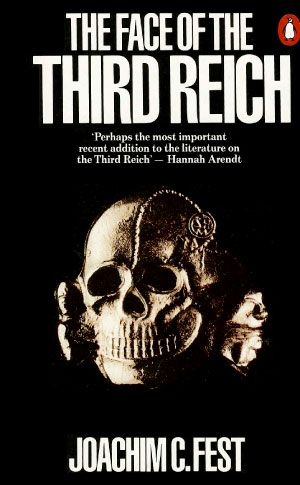
In these searing profiles the author dissects the lives of fifteen infamous Nazis—including Hermann Göring, Joseph Goebbels, Heinrich Himmler, Martin Bormann, Ernst Röhm, Hans Frank, Rudolph Höß, Albert Speer, and Hitler himself. He also analyzes the archetypal roles of the officer corps, intellectuals, and women. This work provides fresh perspectives into how dysfunctional psyches, personal ambitions, and ruthless rivalries impacted the creation and evolution of Hitler's Third Reich.
Edited by: Omer Bartov, 2000
The Holocaust: Origins, Implementation, Aftermath
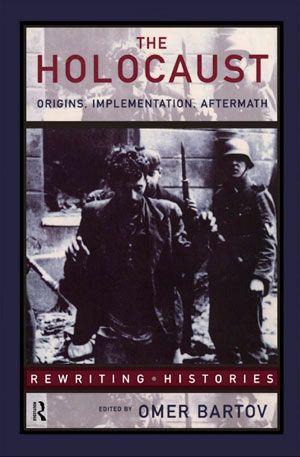
The Holocaust: Origins, Implementation, Aftermath presents a critical and important study of the Holocaust. Complete with an introduction that summarises the state of the field, this book contains major reinterpretations by leading holocaust authors along with key texts on testimony, memory, and justice after the catastrophe. Many of the pieces challenge conventional interpretations and truths of the holocaust, whether it has to do with the centrality of anti-Semitism, the importance of economic calculations, or the timing of the decision on the "Final Solution". Starting with the background of the Holocaust by focusing on anti-Semitism and scientific racism as being at the root of the "Final Solution". The book then examines the context of the decision to unleash the genocide of the Jews. Three powerful texts then provide readers with a close look at the psychology of a perpetrator, the attitude of the bystanders, and the fate of the victims. Finally, there is an analysis of survivor's oral testimonies, a deeply revealing discussion on the limits of transmitting the experience of the camps to posterity, and a powerful plea for the prosecution of crimes against humanity.
Contributing authors: Raul Hilberg, Michael Burleigh, Henry Friedlander, Saul Friedlander, Götz Ally, Christian Gerlach, Omer Bartov, Ernst Klee, Willi Dressen, Volker Riess, Gordon Horwitz, Heda Margolius Kovaly, Lawrence Langer, Primo Levi, Alain Finkielkraut
Peter Longerich, 2010
Holocaust - The Nazi Persecution and Murder of the Jews

This masterful history uses an unrivalled range of sources to lay out in clear detail the steps taken by the Nazis that would lead ultimately to the Final Solution. Focusing closely on the perpetrators and exploring the process of decision making, Longerich convincingly shows that anti-Semitism was not a mere by-product of the Nazis' political mobilization or an attempt to deflect the attention of the masses. Rather, from 1933, anti-Jewish policy was a central tenet of the Nazi movement's attempts to implement, disseminate, and secure National Socialist rule—and one which crucially shaped Nazi policy decisions.
Holocaust is perhaps most remarkable for its extensive use of the 1930s archives of the Central Association of German Citizens of the Jewish Faith, which re-emerged in the 1990s after years languishing in Moscow. The letters and reports from this archive document in detail the attacks suffered by ordinary Jewish people from their German neighbors. They show how, contrary to what has been believed in the past, the German populace responded relatively enthusiastically to Nazi anti-Semitism.
This long-awaited English edition has been fully updated by Longerich himself. It features revised appendices with notes and further reading, as well as a new preface by the author. In addition, Longerich has added new material on the Jewish victims and on the camps and the ghettos, and has extended the story from the end of the war right up to the present day. In all, it is the most complete treatment ever published on the history of this monumental tragedy.
Ronald M. Smelser, 2001
Learning About the Holocaust - A Student's Guide
4 volume set
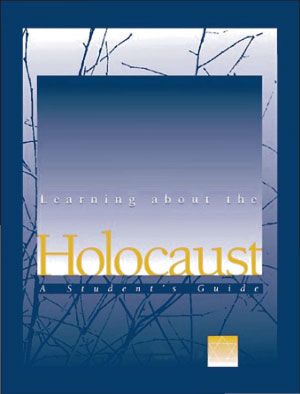
This masterfully amended resource based on Israel Gutman's Encyclopedia of the Holocaust (Macmillan, 1989) contains more than 300 entries. One-third of the authoritative, alphabetical articles are biographical in nature; others cover laws, countries, concepts, sites, etc. Political, sociological, psychological, religious, and economic factors that impacted upon the people and events involved are factored into the entries, which all conclude with a bibliography. Throughout, new and updated information and lists have been added, including a six-page bibliography of works published since 1990. The first volume begins with a detailed time line; the fourth has an especially valuable glossary and selection of primary documents. Robert Rozett's and Shmuel Spector's Encyclopedia of the Holocaust (Facts On File, 2000) is both an insightful history of the Holocaust and a solid reference work. However, Learning has more of a narrative flow in its writing style.
Saul Friedländer, 1997
Nazi Germany and the Jews: Years of Persecution 1933-1939
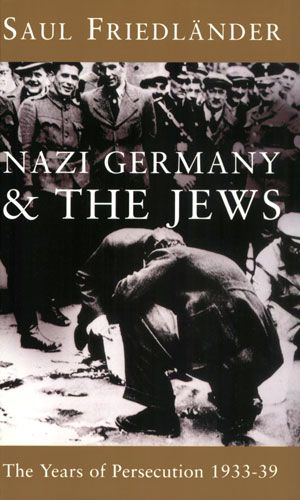
Himself a survivor, Friedländer has been a leading figure in 'Holocaust Studies' for decades and this book represents a magesterial summing up of his research and that of hundreds of other historians. It should remain a standard work for students and others for many years Nazi Germany and the Jews is perhaps the richest examination of the subject yet written, and, crucially, one that never loses sight of the experiences of individuals in its discussion of Nazi politics and the terrible statistics and technological and administrative sophistication of the Final Solution.
Saul Friedländer, 2007
Nazi Germany and the Jews, 1939-1945: The Years of Extermination
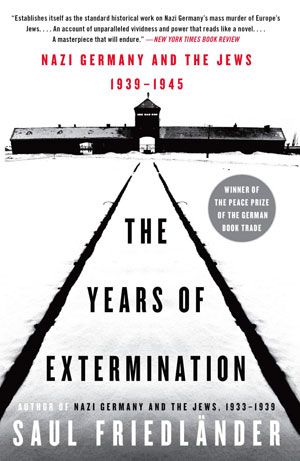
The enactment of the German extermination policies that resulted in the murder of six million European Jews depended upon many factors, including the cooperation of local authorities and police departments, and the passivity of the populations, primarily of their political and spiritual elites. Necessary also was the victims' willingness to submit, often with the hope of surviving long enough to escape the German vise. The Years of Extermination, the completion of Saul Friedländer's major historical opus on Nazi Germany and the Jews, explores the convergence of the various aspects of this most systematic and sustained of modern genocides. In this unparalleled work—based on a vast array of documents and an overwhelming choir of voices from diaries, letters, and memoirs—the history of the Holocaust has found its definitive representation.
Saul Friedländer, 2009
Nazi Germany and the Jews, 1933-1945: Abridged Edition
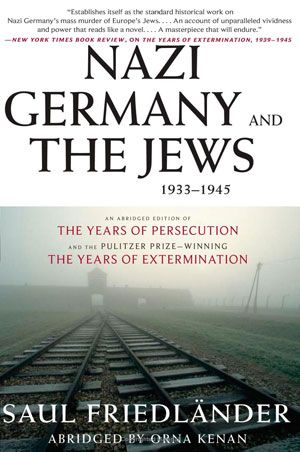
Nazi Germany and the Jews, 1933-1945 is an abridged edition of Saul Friedländer's definitive Pulitzer Prize-winning two-volume history of the Holocaust: Nazi Germany and the Jews: The Years of Persecution, 1933-1939 and The Years of Extermination: Nazi Germany and the Jews, 1939-1945.
The book's first part, dealing with the National Socialist campaign of oppression, restores the voices of Jews who were engulfed in an increasingly horrifying reality following the Nazi accession to power. Friedländer also provides the accounts of the persecutors themselves—and, perhaps most telling of all, the testimonies of ordinary German citizens who, in general, stood silent and unmoved by the increasing waves of segregation, humiliation, impoverishment, and violence.
The second part covers the German extermination policies that resulted in the murder of six million European Jews—an official program that depended upon the cooperation of local authorities and police departments, the passivity of the populations, and the willingness of the victims to submit in desperate hope of surviving long enough to escape the German vise.
A monumental, multifaceted study now contained in a single volume.
Edited by: Simone Gigliotti, Berel Lang, 2005
The Holocaust - A Reader
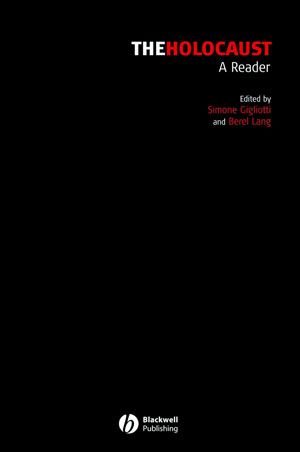
This interdisciplinary collection of primary and secondary readings encourages scholars and students to engage critically with current debates about the origins, implementation and postwar interpretation of the Holocaust.
• Interdisciplinary content encourages students to engage with philosophical, political, cultural and literary debate as well as historiographical issues.
• Integrates oral histories and testimonies from both victims and perpetrators, including Jewish council leaders, victims of ghettos and camps, SS officials and German soldiers.
• Subsections can be used as the basis for oral or written exercises.
• Whole articles or substantial extracts are included wherever possible.
"The greatest attribute of The Holocaust is quite simply the work itself as a whole. Rather than a comprehensive history of the Holocaust told from the point of view of one scholar, Gigliotti and Lang present primary and secondary works that approach the subject from historical, ethical, philosophical, sociological, and legal viewpoints. As a result, the editors not only appeal to a wide audience, but they also encourage cooperation between many fields of study. Simone Gigliotti and Berel Lang's contribution should become a staple in undergraduate and graduate seminars on the Holocaust and genocide for years to come, so the next generation of scholars will not forget and will begin their own efforts to understand." — H-Net Reviews
Edited by: Walter Laqueur, 2001
The Holocaust Encyclopedia
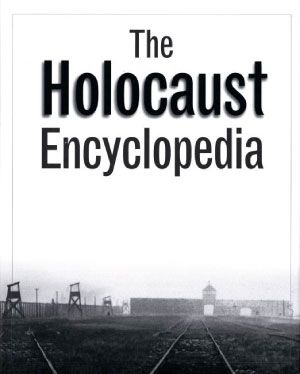
The Holocaust has been the subject of countless books, works of art, and memorials. Fiftyfive years after the fact the world still ponders the enormity of this disaster. The Holocaust Encylopedia is the only comprehensive single-volume work of reference providing both a reflective overview of the subject and abundant detail concerning major events, policy, decisions, cities, and individuals, Up-to-date and designed for easy access, the encyclopedia presents information on the major aspects of the Holocaust in essays by scholars from eleven countries who draw on a number of sources - including recently uncovered evidence from the former Soviet bloc - to provide in-depth studies on the political, social, religious, and moral issues of the Holocaust as well as short entries identifying events, sites, and individuals. The book also has more than 250 photographs, many of them rare, and 19 maps. The volume includes: Raul Hilberg on concentration camps and Gypsies; Ruth Bondy, Israel Gutman, and Dina Porat on major ghettoes; Roger Greenspun on the Holocaust in cinema and television; Richard Breitman on American policy; Michael Berenbaum on theological and philosophical responses; Saul Friedlander on Nazi policy; Michael Hagemeister on the Protocols of the Elders of Zion; Michael R. Marrus on historiography; Christopher R. Browning on the Madagascar Plan; Robert S. Wistrich on Holocaust denial; James E. Young on Holocaust literature;
Editor Laqueur, a notable Holocaust historian, has done a masterful job of bringing together more than 100 contributors from nearly a dozen countries, including such leading scholars in their fields. The result is a comprehensive—one is tempted to say exhaustive, but the subject can never be exhausted—volume. Of particular value are a 17-page chronology of events; the bibliographical essay by Robert Rozett, director of the Yad Vashem Library in Jerusalem; and Adam Kaczkowski's haunting and powerful photographs. These are joined by approximately 250 illustrations that cover all aspects of the Nazi extermination program but also offer intimate portraits of the culture of Jewish life in Nazi-occupied Europe.
- Log in to post comments
